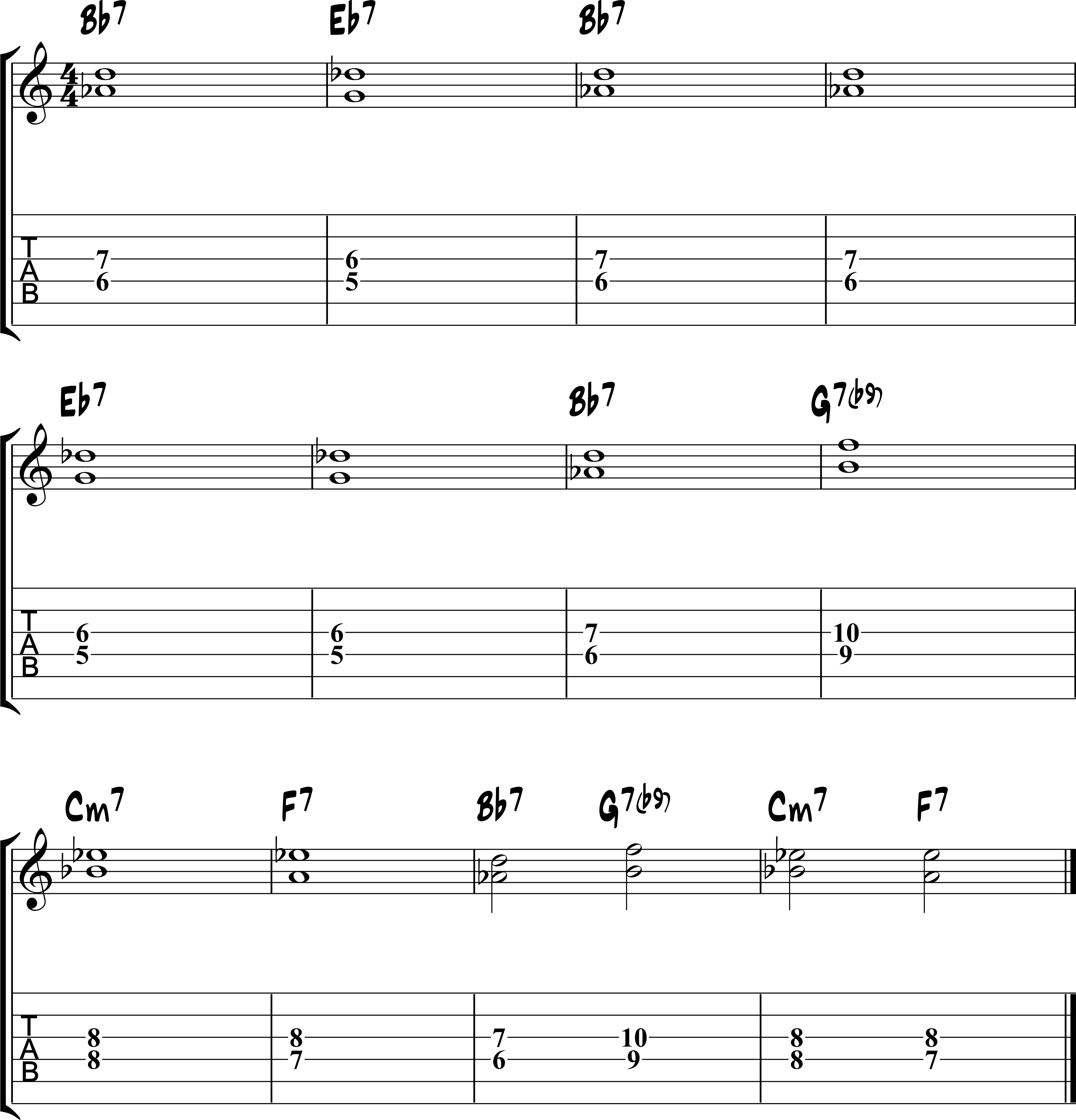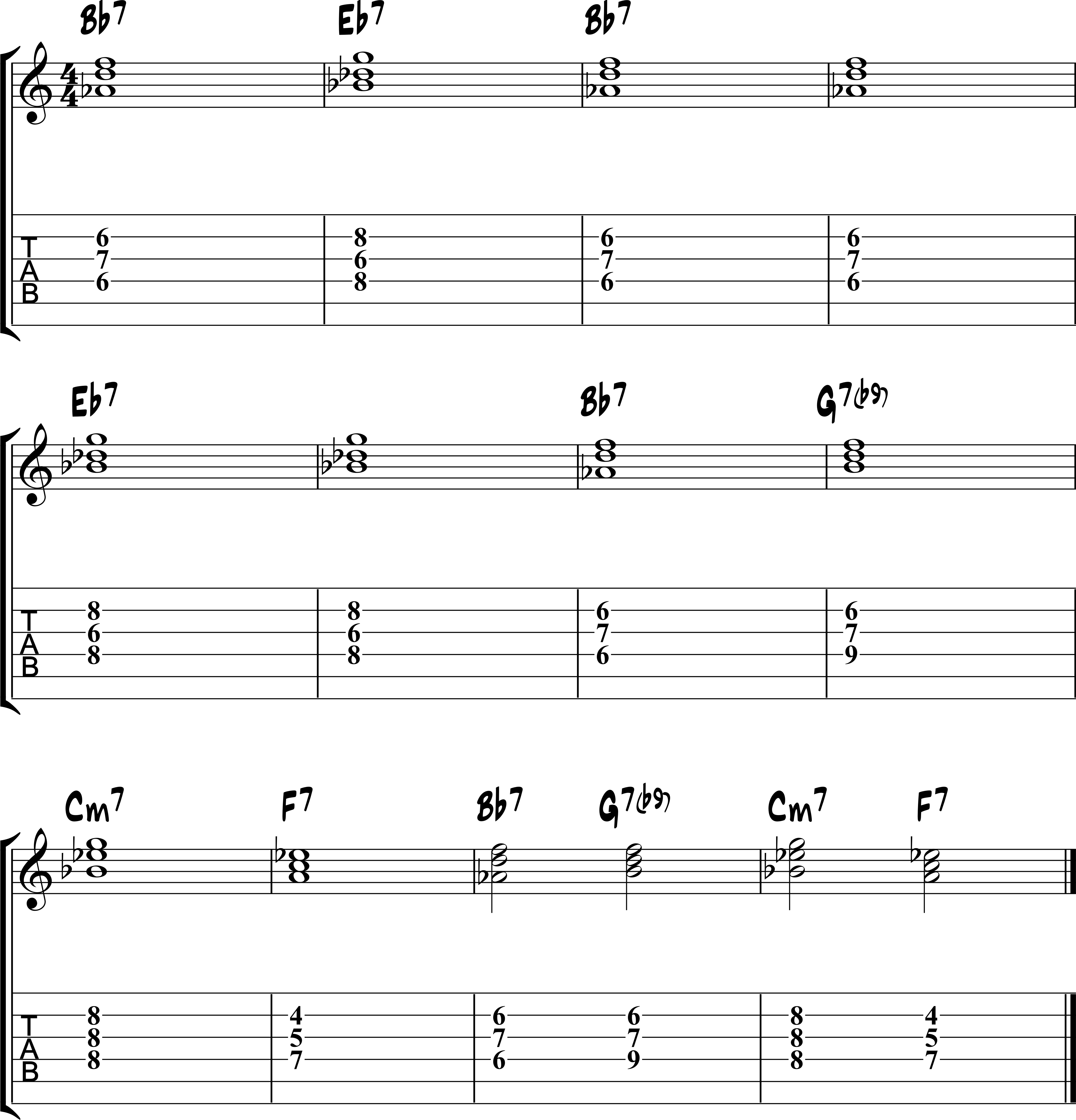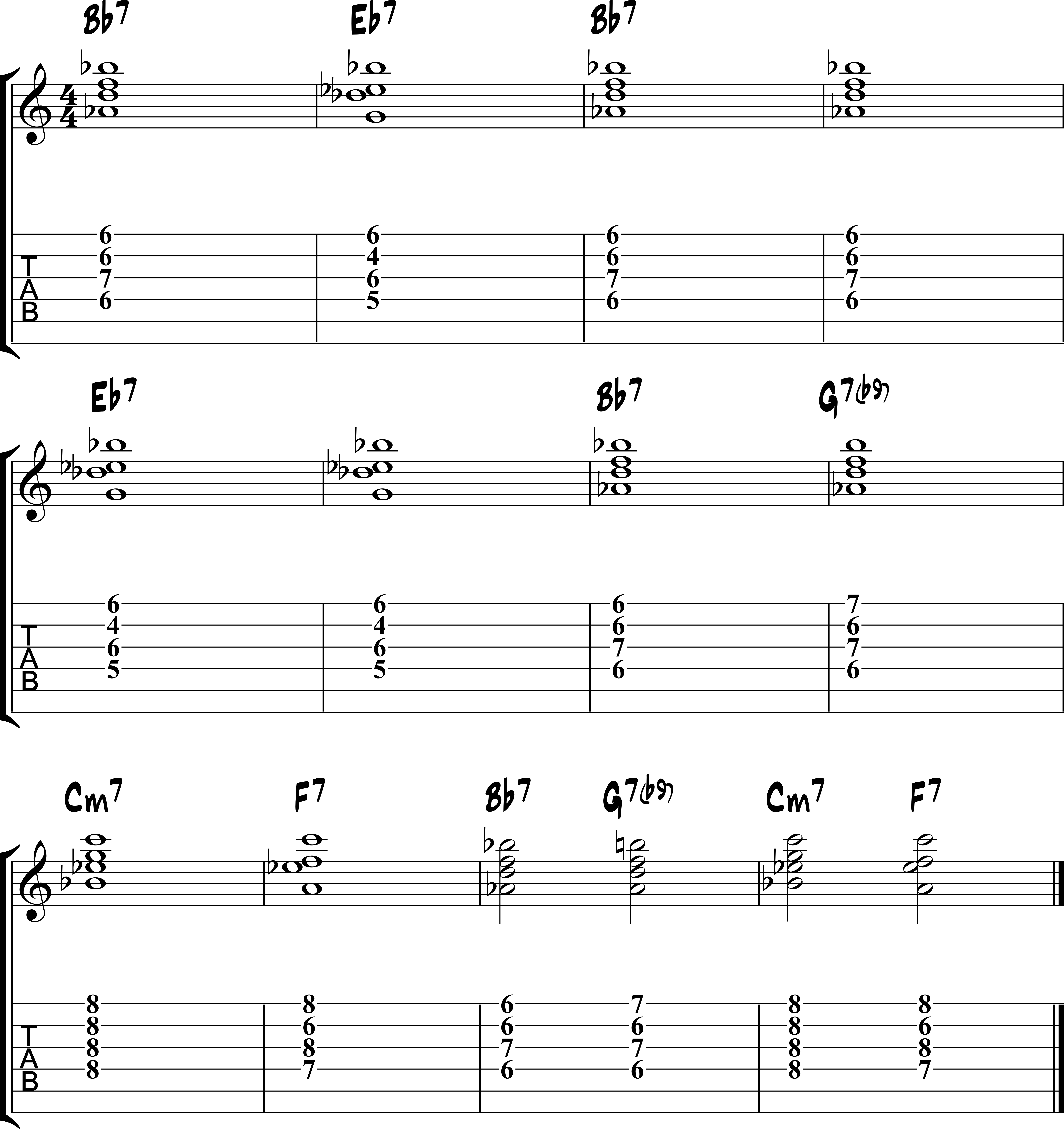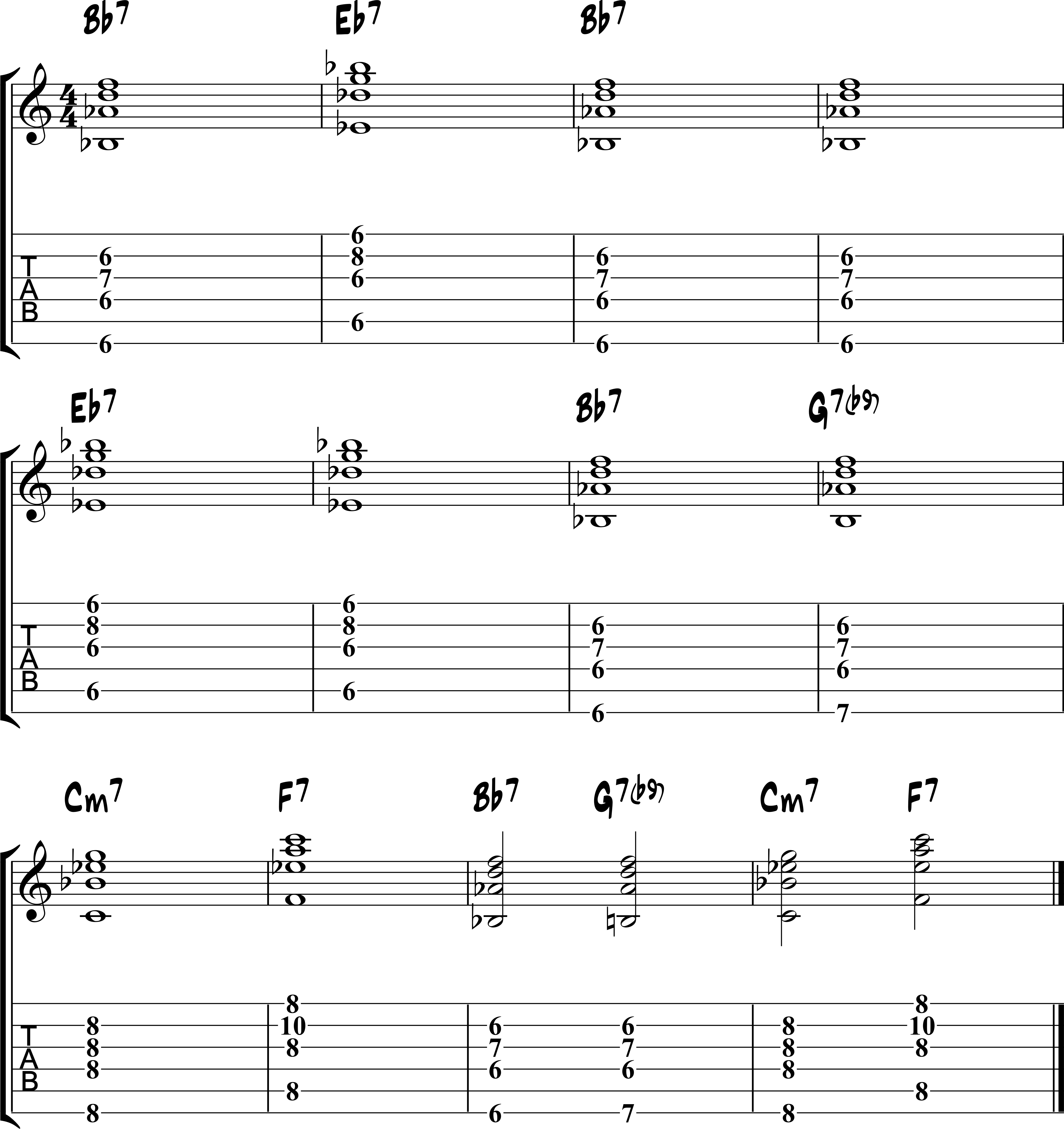5 Levels of Jazz Blues Chords
Playing jazz guitar means learning how to play jazz blues chords in a variety of textures, progressions, and musical situations.
In this lesson, you learn 5 ways to play jazz blues chords. The 5 levels of jazz blues chords are:
1. Guide Tones
2. Triads
3. Drop 2 Chords
4. Drop 3 Chords
5. Rootless Chords
Start by learning any of these jazz blues chords with the plain rhythm. Then, check out the rhythm supplement at the end of the lesson to add rhythmic variations.
As well, I’ve written out each level of jazz blues chords over a Bb jazz blues progression.
After you can play any/all of these chords in the key of Bb, transpose them to F, G, C, and Eb, or all 12 keys if possible, to take these studies further on the fretboard.
Have fun exploring these 5 levels of jazz blues chords as you learn new chord shapes and level up your comping vocabulary at the same time.
Note: In the musical examples below, I play creative versions of the chords by adding in rhythms, picking, articulation, etc. so you hear these shapes in context.
Jazz Blues Level 1 - 3rds and 7ths
The first level features the smallest shapes in this lesson.
Don’t let their size fool you, 3rds and 7ths are powerful jazz blues comping devices.
Also referred to as “guide tones,” the 3rd and 7th outline the chords, lead you through the progression, and are easy to play for most guitarists.
Many guitarists comp with guide tones, and they’re most associated with Lenny Breau’s chord sound.
Have fun digging into level 1 of this lesson, getting these guide tones under your fingers, and building a foundation for the next four levels of jazz blues chords.
Jazz Blues Chord Audio 1
Bb Jazz Blues Backing Track

Jazz Blues Level 2 - 3 to 7 Triads
The second level builds on the first by adding the 5th to each chord in the progression.
When you add a 5th to guide tones, you get the intervals 3-5-7 for each chord.
These three notes form triads for each chord in a jazz blues. These triads are:
- Bb7 = Ddim
- Eb7 = Gdim
- G7b9 = Bdim
- Cm7 = Eb
For each of the dominant chords in a jazz blues, you can comp with the diminished triad from the 3rd of those chords.
When you get to the iim7 chord, Cm7 in this key, you can play a major triad from the b3 of that chord.
Triads are easy to play for most guitarists, and in this context, they outline the chords with a bit more “beef” compared to guide tones.
Once you have these shapes down, mix them up with guide tones to explore creative combinations in your jazz blues comping.
Jazz Blues Chord Audio 2
Bb Jazz Blues Backing Track

Jazz Blues Level 3 - Drop 2 Chords
The next level of jazz blues chords features some of my favorite comping shapes, drop 2 chords.
You can often hear Wes Montgomery and George Benson using drop 2 chords in their comping and chord soloing.
Drop 2 chords are played on adjacent strings, no string skips, and have the interval structures:
- Root Position = R-5-7-3
- 1st Inversion = 3-7-R-5
- 2nd Inversion = 5-R-3-7
- 3rd Inversions = 7-3-5-R
I’ve used drop 2 chords on the top-4 strings here, and you can also play drop 2 jazz blues chords on the middle four strings, 5432.
You can play drop 2 chords on the bottom four strings, 6543, as long as you adjust your tone, so they don’t become too muddy in that range.
Have fun exploring these shapes and mix them with guide tones and triads in your jazz blues comping when ready.
Jazz Blues Chord Audio 3
Bb Jazz Blues Backing Track

Jazz Blues Level 4 - Drop 3 Chords
In level 4, you explore Drop 3 chords, which I associate with Joe Pass and his chord melody, comping, and chord soloing.
Drop 3 chords are played on the 6432 and 5321 string sets, so they have a string skip between the bottom two notes.
As well, drop 3 chords use the interval patterns:
- Root Position – R-7-3-5
- 1st Inversion – 3-R-5-7
- 2nd Inversion – 5-3-7-R
- 3rd Inversion – 7-5-R-3
When playing drop 3 jazz blues chords, make sure to nail the string skip, avoid hitting that open string or fretting a note that’s not in the chord.
Using hybrid picking (fingers + pick) works well with Drop 3 chords, as do fingerstyle playing.
You can strum drop 3 chords, just watch that string skip and all good.
Jazz Blues Chord Audio 4
Bb Jazz Blues Backing Track

Jazz Blues Level 5 - Rootless Chords
The final level of jazz blues chords features more of my favorite shapes, rootless chords.
Here, you play shapes that bring new colors to each chord while leaving the root to the bassist.
These shapes can be heard clearly in the comping of Ed Bickert, Jim hall, and many others.
When learning rootless chords, find a close root note to use as a reference.
You won’t play that root note, and it can be a useful tool when transposing these shapes to other keys.
Once you get these shapes under your fingers, mix them together with any/all of the previous four levels for a creative comping experience.
Jazz Blues Chord Audio 5
Bb Jazz Blues Backing Track

Jazz Blues Rhythms
Here are eight different jazz rhythms that you can use with any of the chords above.
Pick one rhythm, one bar, and comp with that rhythm over backing tracks using shapes from levels 1 to 5 of the jazz blues.
Once you have two rhythms down, mix them together.
When you mix different rhythms and different chord shapes together, you create endless variations in your jazz blues comping.

